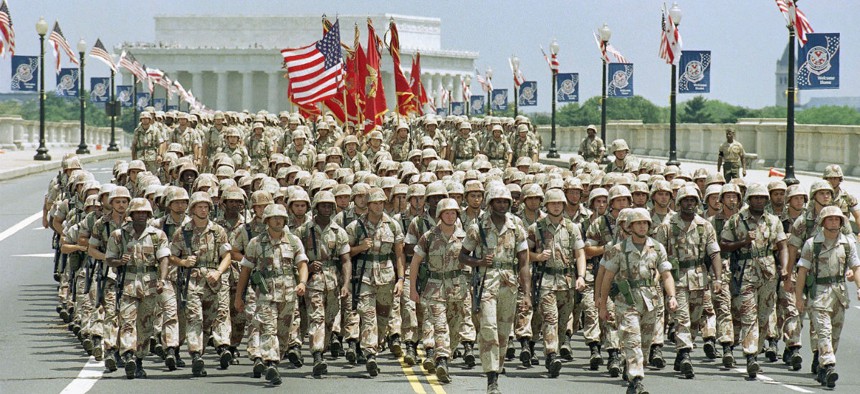
Troops march across the Memorial Bridge towards the Pentagon during 1991 National Victory Celebration Parade in Washington. It was the largest U.S. military parade since World War II. AP file photo
Trump’s Proposed Military Parade Already Needs an Audit
The full costs won't be known until long after the confetti has been cleaned from the streets.
President Trump has proposed organizing a special military parade to honor members of the armed forces. It would be the first such parade since the 1991 National Victory Celebration marking the end of the Gulf War. With the deficit ballooning, the idea has raised concerns about it costs. The 1991 parade had a reported price tag of $12 million, equal to $22 million in 2018 dollars. Office of Management and Budget Director Mick Mulvaney told a congressional panel that the costs would be between $20 million and 30 million. While that range is in line with an extrapolation of the 1991 event, current defense costs and security requirements could push the price tag much higher.
Decades have passed since the last parade, and it’s difficult to find a detailed breakdown of the costs that went into that $12 million figure. According the Washington Post at the time: “Most of the public money will be spent flying the troops here from military bases around the country and Europe and housing them in college dormitories, military barracks and hotels. Tanks, missiles, a 50-bed military hospital and other pieces of heavy equipment used in the war also are being shipped by rail and truck.” Initially, organizers hoped to bring 10,000 Gulf War veterans to the parade, but that figure was scaled back because of the cost concerns.
The parade also included a flyover of 83 military aircraft. It is unclear how much of the cost of this was reflected in the parade’s price tag, since “Air Force and Army officials [said] the trips to Washington [were] counted as training flights for the aircraft crews.” The flyover costs would be much higher today because the cost-per-flight hour for aircraft has grown precipitously. For example, in 1991 it cost $4,000 ($7,400 in 2018 dollars) per hour to fly an F-15 Eagle, compared to recent figures showing costs of $8,600 for an F-15D and $22,500 for an F-15C. The F-15’s replacement, the F-22 Raptor, is even costlier at nearly $36,000 per flight hour.
Like presidential inaugurations and other major events where many dignitaries and a large public crowd are expected, the parade would be considered a National Special Security Event, making the U.S. Secret Service the lead agency for planning and coordinating security. For FY 2017, the Secret Service’s special events budget totaled $52 million (compared to $4.5 million for 2018). Additional inauguration-related funding has been annually appropriated by Congress since 2001, starting at $6 million and rising to $20 million for 2017.
The ultimate costs to the military would depend on the length of the parade, but the security costs for setting up a perimeter zone around the parade route would likely be in line with the amount required for the 2017 inauguration. The costs for the 1991 Victory Celebration were partially defrayed by public donations of at least $3.5 million. Holding that event on a Saturday helped to keep costs down too, as it was not necessary to close government offices or give federal employees a bonus paid-leave day.
Mulvaney suggested that existing funds could be repurposed to cover the costs of the parade. That would still represent either a drain on other resources or a redirection of money that could otherwise be used to reduce the deficit. Moreover, there is a lack of transparency associated with events like the formerly-held Public Service Appreciation Day expo on the National Mall or presidential trips abroad. A full accounting of the expenses would require a comprehensive review by the Government Accountability Office, which wouldn’t be completed until long after the confetti has been cleaned from the streets.
Demian Brady is the Director of Research for the National Taxpayers Union Foundation, a nonprofit research organization devoted to holding government at all levels accountable to taxpayer concerns.






